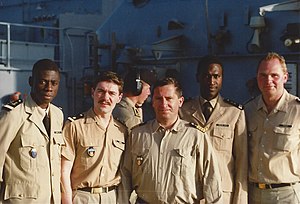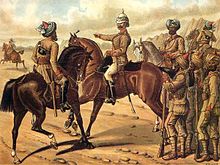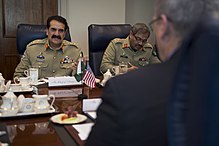| Revision as of 01:44, 20 August 2024 editZefr (talk | contribs)Extended confirmed users, Pending changes reviewers69,550 edits Reverted 1 edit by 114.10.139.86 (talk): Nothing unique in the image or captionTags: Twinkle Undo← Previous edit | Revision as of 07:43, 20 August 2024 edit undo114.10.139.54 (talk) →Use in civilian clothingTags: Reverted Mobile edit Mobile web editNext edit → | ||
| Line 36: | Line 36: | ||
| == Use in civilian clothing == | == Use in civilian clothing == | ||
| Following World War II, military-issue khaki-colored ] twill trousers became a common part of civilian clothing. Today, the term ''khakis'' is sometimes used to refer to the style of trousers, properly called chinos, regardless of their color. | Following World War II, military-issue khaki-colored ] twill trousers became a common part of civilian clothing. Today, the term ''khakis'' is sometimes used to refer to the style of trousers, properly called chinos, regardless of their color. | ||
| == Use in civilian servant == | |||
| ] in ].]] | |||
| === The History of Indonesian Civil Servants’ Uniform === | |||
| Surely you’re keen to know the meaning behind Indonesian ASN uniform and its golden brown palette, aren’t you? Well, the story began when Sir Henry Lawrence, a British Officer who served in India in the 1840s. He often wore a thin fabric uniform, considering the extreme weather there. To reduce the impact of the stiflingly hot weather, he covered his clothes with ‘khaki’, which means ‘dirt’, referring to soil. | |||
| He believed that ‘khaki’ could help him cool down his body temperature. Since then, this soil colour is used as the basic colour of Indonesian ASN uniform nowadays. In addition, there are three main philosophical bases as to why ‘khaki’ colour is applied on Indonesian ASN uniforms.<ref>{{cite web | url=https://www.ptsansan.co.id/en/the-meaning-behind-indonesian-asn-uniform/ | title=History of Civil Servant uniform in Indonesia| date=20 August 2024 }}</ref> | |||
| * '''Reflecting Human’s Trait of Being Humble''' | |||
| The color of the soil used in civil servant uniform aims to form a humble attitude and personality in doing their duties. ASN officers, whose daily work is in the office, are required to be humble, avoiding any arrogant traits. If any kind of arrogance occurs within the scope of ASN, they will lose respect from their environment. | |||
| * '''As a Reminder of the Hard Work during Service''' | |||
| The color of ‘khaki’ is also a reminder of ASN’s effort during their service to the nation. Salaries, allowances, and so on are the results of their hard work, which were achieved in a path full of twists. That’s why it’s closely associated with the term “don’t bite the hand that feeds you.” | |||
| * '''Easily Recognized by the Public''' | |||
| It cannot be denied that the color of khaki is indeed the one of the most easily recognized by the public in Indonesia. When looking at this uniform, it is easy for other people to guess that its user is definitely a civil servant or state civil apparatus (ASN). This recognition shall be a foundation for each and every ASN in giving service to the public. | |||
| So, those are some fun facts you need to know about the meaning behind Indonesian ASN uniforms. To meet the needs of state institutions, PT Sansan Saudaratex Jaya Textile Division is capable of producing high quality ASN uniforms. We can help you manufacture any kind of uniform, with a capacity for sewing reaching up to 3,000,000 meters / month, making the results even more optimal. | |||
| ==Tones of khaki== | ==Tones of khaki== | ||
Revision as of 07:43, 20 August 2024
Color of tan commonly found in arid-region military uniformsThis article is about khaki as a color. For other uses, see Khaki (disambiguation).

The color khaki (UK: /ˈkɑːki/, US: /ˈkæki/) is a light shade of tan with a slight yellowish tinge.
Khaki has been used by many armies around the world for uniforms and equipment, particularly in arid or desert regions, where it provides camouflage relative to sandy or dusty terrain. It has been used as a color name in English since 1848 when it was introduced as a military uniform. In Western fashion, it is a standard color for smart casual dress trousers for civilians, which are also often called khakis.
In British English and some other Commonwealth usage, khaki may also refer to a shade of green known as olive drab.
Etymology
Khaki is a loanword from Urdu خاکی 'soil-colored', which in turn comes from Persian خاک Template:IPA-fa khāk 'soil' + ی (adjectival attributive suffix); it came into English via the British Indian Army.
Origin

Khaki was first worn as a uniform in the Corps of Guides that was raised in December 1846 by Henry Lawrence (1806–1857), agent to the Governor-General for the North-West Frontier and stationed in Lahore. Initially the border troops were dressed in their native costume, which consisted of a smock and white pajama trousers made of a coarse home-spun cotton, and a cotton turban, supplemented by a leather or padded cotton jacket for cold weather. In 1848, a khaki uniform was introduced. Subsequently, all regiments serving in the region, whether British or Indian, had adopted khaki uniforms for active service and summer dress. The original khaki fabric was a closely twilled cloth of linen or cotton.
Military use

The impracticality of traditional bright colors such as the red coat, especially for skirmishing, was recognised early in the 19th century. A response to improved technologies such as aerial surveillance and smokeless powder, khaki could camouflage soldiers in the field of battle.
Khaki-colored uniforms were used officially by British troops for the first time during the 1868 Expedition to Abyssinia, when Indian troops traveled to Ethiopia. Subsequently, the British Army adopted khaki for colonial campaign dress and it was used in the Mahdist War (1884–89) and Second Boer War (1899–1902). These uniforms became known as khaki drill, versions of which are still part of the uniforms of the British Army.
During the Second Boer War, the British forces became known as Khakis because of their uniforms. After victory in the war, the government called an election, which became known as the khaki election, a term used subsequently for elections called to exploit public approval of governments immediately after military victories.
The United States Army adopted khaki during the Spanish–American War (1898), replacing their traditional blue field uniforms. The United States Navy and United States Marine Corps followed suit, authorizing khaki field and work uniforms.

When khaki was adopted for the continental British Service Dress in 1902, the shade chosen had a clearly darker and more green hue (see photo). This color was adopted with minor variations by all the British Empire armies. The 1902 US Army uniform regulations also adopted a similar shade for soldiers' winter service uniforms under the name olive drab. This shade of brown-green remained in use by many countries throughout the two World Wars.
Use in civilian clothing
Following World War II, military-issue khaki-colored chino cloth twill trousers became a common part of civilian clothing. Today, the term khakis is sometimes used to refer to the style of trousers, properly called chinos, regardless of their color.
Use in civilian servant

The History of Indonesian Civil Servants’ Uniform
Surely you’re keen to know the meaning behind Indonesian ASN uniform and its golden brown palette, aren’t you? Well, the story began when Sir Henry Lawrence, a British Officer who served in India in the 1840s. He often wore a thin fabric uniform, considering the extreme weather there. To reduce the impact of the stiflingly hot weather, he covered his clothes with ‘khaki’, which means ‘dirt’, referring to soil.
He believed that ‘khaki’ could help him cool down his body temperature. Since then, this soil colour is used as the basic colour of Indonesian ASN uniform nowadays. In addition, there are three main philosophical bases as to why ‘khaki’ colour is applied on Indonesian ASN uniforms.
- Reflecting Human’s Trait of Being Humble
The color of the soil used in civil servant uniform aims to form a humble attitude and personality in doing their duties. ASN officers, whose daily work is in the office, are required to be humble, avoiding any arrogant traits. If any kind of arrogance occurs within the scope of ASN, they will lose respect from their environment.
- As a Reminder of the Hard Work during Service
The color of ‘khaki’ is also a reminder of ASN’s effort during their service to the nation. Salaries, allowances, and so on are the results of their hard work, which were achieved in a path full of twists. That’s why it’s closely associated with the term “don’t bite the hand that feeds you.”
- Easily Recognized by the Public
It cannot be denied that the color of khaki is indeed the one of the most easily recognized by the public in Indonesia. When looking at this uniform, it is easy for other people to guess that its user is definitely a civil servant or state civil apparatus (ASN). This recognition shall be a foundation for each and every ASN in giving service to the public.
So, those are some fun facts you need to know about the meaning behind Indonesian ASN uniforms. To meet the needs of state institutions, PT Sansan Saudaratex Jaya Textile Division is capable of producing high quality ASN uniforms. We can help you manufacture any kind of uniform, with a capacity for sewing reaching up to 3,000,000 meters / month, making the results even more optimal.
Tones of khaki
Light khaki
| Light Khaki | |
|---|---|
| Hex triplet | #F0E68C |
| sRGB (r, g, b) | (240, 230, 140) |
| HSV (h, s, v) | (54°, 42%, 94%) |
| CIELChuv (L, C, h) | (90, 62, 80°) |
| Source | X11 |
| ISCC–NBS descriptor | Light greenish yellow |
| B: Normalized to (byte) | |
At right is displayed the color light khaki (also called khaki tan or just tan).
Khaki
| Khaki (HTML/CSS) | |
|---|---|
| Hex triplet | #C3B091 |
| sRGB (r, g, b) | (195, 176, 145) |
| HSV (h, s, v) | (37°, 26%, 76%) |
| CIELChuv (L, C, h) | (73, 28, 61°) |
| Source | HTML/CSS |
| ISCC–NBS descriptor | Grayish yellow |
| B: Normalized to (byte) | |
This is the web color called khaki in HTML/CSS.
The color shown at right matches the color designated as khaki in the 1930 book A Dictionary of Color, the standard for color nomenclature before the introduction of computers.
Dark khaki
| Dark Khaki | |
|---|---|
| Hex triplet | #BDB76B |
| sRGB (r, g, b) | (189, 183, 107) |
| HSV (h, s, v) | (56°, 43%, 74%) |
| CIELChuv (L, C, h) | (73, 52, 82°) |
| Source | X11 |
| ISCC–NBS descriptor | Moderate greenish yellow |
| B: Normalized to (byte) | |
At right is displayed the web color dark khaki.
It corresponds to Dark Khaki in the X11 color names.
Khaki green
| Khaki green | |
|---|---|
| Hex triplet | #728639 |
| sRGB (r, g, b) | (114, 134, 57) |
| HSV (h, s, v) | (76°, 57%, 53%) |
| CIELChuv (L, C, h) | (53, 48, 101°) |
| Source | wikimix |
| ISCC–NBS descriptor | Pale olive brown |
| B: Normalized to (byte) | |
At right is displayed the color khaki green, sometimes called simply khaki in Commonwealth countries. It is more commonly called olive green or olive drab.
See also
References
- Maerz and Paul A Dictionary of Color New York:1930 McGraw-Hill Page 197; Color Sample of Khaki: Page 49 Plate 13 Color Sample J7
- "Khaki entry in Cambridge Dictionary". Cambridge Dictionary. Retrieved 25 November 2020.
- "Khaki definition and meaning | Collins English Dictionary". www.collinsdictionary.com.
- Sykes, Pandora. "Wardrobe Mistress: how to tackle the khaki jacket". The Times. The Times (of London). Retrieved 22 December 2020.
- Dictionary Meaning: Khaki; TheFreeDictionary; Free Online Dictionary, Thesaurus, and Encyclopedia
- ^ St. Clair, Kassia (2016). The Secret Lives of Colour. London: John Murray. pp. 240–241. ISBN 9781473630819. OCLC 936144129.
- "Khaki Uniform 1848–49: First Introduction by Lumsden and Hodson", Journal of the Society for Army Historical Research, 82 (Winter 2004) pp 341–347
- Williams, Cynric R. (1827). Hamel, the Obeah man (1st ed.). London: Hunt and Clarke. p. 279. Retrieved 3 February 2016."...A red-coat on one of these rocks will only be a mark for these rebels."
- "The Army". Blackwood's Edinburgh Magazine. 60 (370): 144. "...scarlet is unmilitary, first, because it is tawdry ; and secondly, as rendering the soldier, when isolated, an easier mark than a less glaring colour." (1846)
- Tynan, Jane (2013). British Army Uniform and the First World War: Men in Khaki. London: Palgrave MacMillan.
- Byron Farwell, Armies of the Raj, 1989, page 75.
- "History of Civil Servant uniform in Indonesia". 20 August 2024.
- Çelik, Tantek; Lilley, Chris; Baron, L. David; W3C; Baron, L. David (19 June 2018). "CSS Color Module Level 3". www.w3.org. Retrieved 22 October 2018.
{{cite web}}: CS1 maint: numeric names: authors list (link) - CSS3 Color Module, retrieved 2010-09-12
External links
- [REDACTED] The dictionary definition of khaki at Wiktionary
- [REDACTED] Media related to khaki at Wikimedia Commons
| Shades of yellow | |||||||||||||||||||||||||||||||||||||||||||||||||||||||||||||||||||||||||||||||||||||||||||||||||||||||||
|---|---|---|---|---|---|---|---|---|---|---|---|---|---|---|---|---|---|---|---|---|---|---|---|---|---|---|---|---|---|---|---|---|---|---|---|---|---|---|---|---|---|---|---|---|---|---|---|---|---|---|---|---|---|---|---|---|---|---|---|---|---|---|---|---|---|---|---|---|---|---|---|---|---|---|---|---|---|---|---|---|---|---|---|---|---|---|---|---|---|---|---|---|---|---|---|---|---|---|---|---|---|---|---|---|---|
| |||||||||||||||||||||||||||||||||||||||||||||||||||||||||||||||||||||||||||||||||||||||||||||||||||||||||
| A typical sample is shown for each name; a range of color-variations is commonly associated with each color-name. | |||||||||||||||||||||||||||||||||||||||||||||||||||||||||||||||||||||||||||||||||||||||||||||||||||||||||